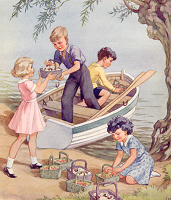
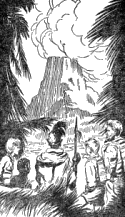
Everyone stares in amazement at the Secret Mountain.
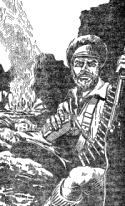
As usual, Ranni keeps guard overnight.
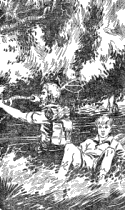
Paul's raft spins into a pool and dumps him out.
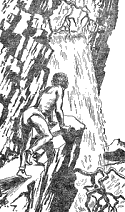
Mafumu approaches the enormous waterfall, looking for a secret way into the mountain.
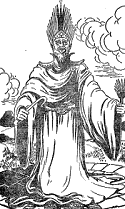
The chief stands majestically on the tower at the summit of the mountain.
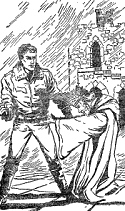
The chief kneels frightened before the powerful Captain Arnold!
The Secret Mountain
Review by Keith Robinson (April 25, 2006)My word, this series is almost on a par with the Adventure series! The Secret Mountain in particular feels very much like one or more of the Adventure books, as the children are trekking through the jungles of Africa to find the strange, foreboding secret mountain where they believe their parents are being held captive. While the Famous Five are confined to Dorset, Devon and Cornwall, and the Five Find-Outers hardly even leave their own village, here we have Mike, Jack, Peggy and Nora, together with Prince Paul, flying to the heart of Africa on a dangerous mission that might just get them all killed!
The story opens with a setup that I thought was a little too fast and more than a little contrived. The first chapter opens with the children at an aerodrome saying goobye to Captain and Mrs Arnold as the "most famous pilots in the world" take off in their small but powerful aeroplane, the White Swallow, on their planned trip to Africa, where it's said they will probably "break another record" in aviation history. Then, a page or so later, the boys and girls are back at their respective schools following the progress of the flight in the newspapers. But one day the headlines reveal something shocking: NO NEWS OF THE ARNOLDS, they announce. STRANGE SILENCE. WHAT HAS HAPPENED TO THE WHITE SWALLOW?
Worry and tension set in, and half-term comes with no sign of the pilots. The children are to stay at their parents' flat in London for a few days, with Dimmy coming to join them from Spiggy Holes, and Prince Paul due to arrive after tea. Dimmy tries to reassure the children that everything is being done to find the Arnolds, and takes them to the cinema where, for a little while at least, they forget their worries. Then Prince Paul arrives, and he's full of excitement. He's been given an aeroplane as a birthday present! And, because Paul is so young, naturally his father has sent him a fine pilot too. Still recovering from their surprise, the children barely have time to comment on what a lucky so-and-so the Prince is when, from outside, a voice yells, "Paper! Evening paper! Lost aeroplane found! White Swallow found!" Eagerly the children rush downstairs to read the news, and they find, to their horror, that their parents' plane has been found somewhere in Africa, safe and sound on the ground but with no sign of the Arnolds. They're still missing, and the natives know nothing.
"I wish to goodness we could go to Africa and look for them," says Mike... And, yes, you guessed it—Prince Paul's eyes shine and he gets all excited and says, "We will go! What about my new aeroplane! We can go in that—and Pilescu, my pilot, can take us!" Oh, how I groaned at the way all this was delivered. It's just soooo convenient. It reminded me of when the Find-Outers were wondering how they could possibly find a pair of twin babies and suddenly, just as they were talking about it, Bets spotted a poster stuck to the window announcing a forthcoming baby show in the village!
But The Secret Mountain is excellent from this point onwards, although don't forget we've only got through one chapter so far! In chapter two the children set about persuading Pilescu, the Prince's pilot, right-hand man, and personal servant, that they should just fly to Africa right away. Pilescu is not happy about it, but agrees, and brings with him another man by the name of Ranni. With these capable adults taking control of the situation, and carrying guns as well, the children are confident and excited about the prospect of flying to Africa to find their parents.
The journey to Africa, and their arrival in the steaming hot country, is handled very well, with much the same feel as those Adventure books mentioned earlier—particularly The Valley of Adventure where the flight is concerned. The Secret Mountain precedes the first of the Adventure books by three years, but you can tell Blyton was very much in the same frame of mind when she brought to life Jack, Philip, Dinah and Lucy-Ann. In fact, given the similiarities and overall feel of these books, you have to wonder if Blyton just took Jack out of the Secret series, gave him a sister, and dropped him into the Adventure series!
One of the natives from a local tribe explains that the Arnolds were taken away by the Folk from the Secret Mountain. Excited by the news, Pilescu and Ranni probe further, and it's agreed that the native will lead them to the so-called Secret Mountain in exchange for what he sees as a magical mirror. The tribesman's nephew, Mafumu, is introduced as a fun, cheeky boy wearing nothing but a skirt of grass. Whilst he is instantly likeable, the uncle is not, and he keeps hitting poor Mafumu unfairly for trivial things such as laughing without permission. This later comes to a head when first Jack, then Ranni, intercepts a savage beating with a spear. Afterwards Mafumu falls at Jack's feet and vows to be his servant forever—just like Oola did with Philip in The River of Adventure.
The Folk of the Secret Mountain, it's said, are strange yellow-skinned people with fiery red hair and green eyes. This is quite a remarkable description for a tribe of people living in Africa, whose neighbors are all "black or brown-skinned." The strangeness of these people make the locals somewhat wary of approaching the mountain, so it's all Ranni can do to convince the guide to continue all the way to the foot of the secret mountain. Oddly, the mountain is also described as yellow, but this is explained by the curious yellow bushes on its slopes. It's later revealed that the odd folk of the mountain paint their skin with yellow paint, and wash bright red dye into their hair—but it's not explained why exactly, other than perhaps to frighten the neighboring tribes. Perhaps that's reason enough. Or perhaps wearing the yellow paint and red dye is a religious thing, since it turns out they worship the sun gods from the flat summit of the mountain... Perhaps the red and yellow are meant to signify the fiery colors of the sun, but it's never outright explained, just hinted at.
Without going into too much detail, the group—Pilescu, Ranni, the four children and Paul, plus Mafumu (but not his uncle, who has gone off home by this time)—end up wandering about inside the mountain. A bunch of them are kidnapped and taken inside, while Jack and Mafumu are left behind to find a way in by themselves. Again hints of The Valley of Adventure come into play as the boys find a secret entrance by the side of an enormous waterfall. The secret passages beyond are truly remarkable, leading up and down, and joining up with a whole catacomb of tunnels and caves, some of which have endless steps carved into them. I couldn't help thinking: Who built all this? How long must it have taken to install heavy wooden doors about the place? And that's before we even get to the throne room, and the temple on the summit...
I had a bit of a problem believing in all the architecture throughout this place, including the lift that the chief or king of the mountain uses. (The idea of a mountain king is later re-used in The Mountain of Adventure.) The lift is described as a golden cage that's hoisted up and down from the throne room via a vertical shaft by twenty men hauling on ropes. I'm perfectly fine with that, despite my reservations about there being a decent, regular-shaped shaft all ready for such a use—because to imagine men carving out such a shaft without machinery is almost unthinkable. The twenty men haul on ropes that hang down from the ceiling of the throne room, so presumably there's a good pulley system in place. The lift rises all the way up to the underside of a round trap door at the top of the shaft, then stops while someone unbolts the trapdoor and opens it. Then the lift rises once more, through the trapdoor opening—to the summit of the mountain! The lift apparently rises out of the floor of the summit and stops so that passengers can step out. The summit is a large area open to the air, so this implies that the ropes are not attached to the top of the lift as you might expect. Gosh, this is some feat of engineering for a bunch of people who live in a mountain and seem to have little or no contact with the outside world. Perhaps the lift was there before them? I always imagined these people, with their yellow skin, as some kind of lost tribe related to the Aztecs of the past... only it turns out these are normal African people with yellow paint on their skin.
So many questions are left unanswered here. The yellow skin and red hair is explained, but if these really are just local Africans dressing up to look different, how come their eyes are described as green? Are they wearing contacts as well? But more importantly, who built their mountain palace, and the temple of carved stone columns on the summit? For that matter, who carved the summit flat in the first place? "It had been levelled till it was completely flat." On three sides of a large square area stand pillared corridors, and on the fourth side stands a great temple-like building. Quite an achievement! The history of this place seems to predate these strange yellow-skinned Folk, and yet nothing is really said about it all beyond the initial visual wonderment.
Still, this Secret Mountain remains, for me, one of the most magnificent semi-natural places created by Enid Blyton, sitting right alongside The Mountain of Adventure in Wales, and the caves, tunnels and waterfall in The Valley of Adventure. This is Blyton on a grand scale. She does lovely picturesque English villages so well, as well as mist-covered moors, peaceful islands, sandy coves with caves and tunnels nearby, and old houses and castles with endless secret passages. But she also does grand adventure in foreign countries, with superstitious natives and ancient ruins and lost treasures.
One thing that doesn't change much, though, is the villain. Whether they're petty thieves, masterful con-men, smugglers, or strange kings that reside inside mountains, they always end up being easily thwarted by the children. In The Secret Mountain this weakness isn't so obvious, partly because the children have Ranni and Pilescu to help them, as well as Captain and Mrs Arnold once they're rescued. In fact, the children are very much along for the ride in this adventure; it's almost too big for them for them to handle alone. And you certainly wouldn't have seen Mike and Jack brandishing a revolver about!
This brings me to one last minor point. Guns are mentioned right at the very start of this adventure, and are mentioned again throughout the journey to the mountain. Ranni is often seen keeping watch overnight, cradling his gun in case of attack by wild animals—or the Folk from the Secret Mountain. But once at the mountain, the guns are completely forgotten, even when it's clear that Prince Paul is being led away to be thrown off the summit as a sacrifice to the sun gods! "I can't see how we can possibly save him," says Captain Arnold, as Nora begins to cry. But save him they do—though not with guns. This is nice in a way, because the rescue is much more exciting and imaginative without the use of guns. But still, you have to wonder why the guns are forgotten ntil the very last minute.
An excellent read, though, even better in some ways than The Secret of Spiggy Holes, although the children did take more of a leading role in that than they did in this, the third in the series.


